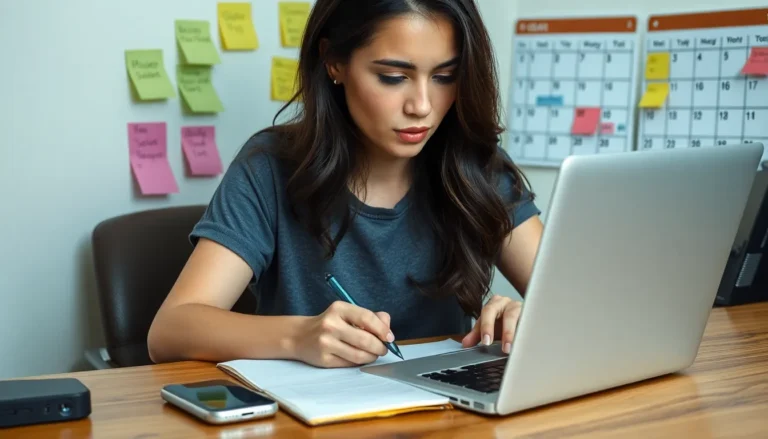Ever found yourself in a conversation with someone who suddenly seems to vanish into thin air? You might think they’ve mastered the art of ghosting, but chances are they’re just glued to their iPhone. In today’s world, where everyone seems to be perpetually attached to their devices, figuring out if someone’s on a call can feel like solving a mystery worthy of Sherlock Holmes.
Table of Contents
ToggleUnderstanding Phone Communication
Observing phone communication provides insight into someone’s engagement level during conversations. Identifying if someone is on a call follows certain signs. Checking the person’s body language serves as an initial clue. Notice if they are focused on their device, typically with their eyes downcast or fingers tapping on the screen.
Listening for specific audio cues also helps in identifying phone use. Sounding like someone is in a call, background noises may emerge, such as voices or alerts. Focusing on the other person’s attention reveals crucial information. Often, individuals on the phone may not respond promptly to spoken prompts.
Assessing the phone’s visual indicators adds another layer of clarity. If the screen is illuminated with an active calling app, that often signifies a conversation is taking place. Observing their proximity to their device also matters. Keeping their phone close indicates a high likelihood of being on a call.
Noticing non-verbal communication can provide additional clarity. Hand gestures or facial expressions might hint at the conversation’s nature. Signs like nodding or smiling could suggest interactive dialogue on the other end. Understanding these signals creates a clearer picture of someone’s communicative state.
Remaining mindful of their verbal responses is crucial as well. Inconsistent answers or delayed reactions often indicate distraction by a call. Recognizing these moments ensures accurate assessment of someone’s availability. Each of these strategies contributes to unraveling the mystery of phone communication effectively.
Signs That Indicate Phone Usage
Observing specific signs can clarify whether someone is engaged with their phone. By recognizing visual and behavioral indicators, one can gauge their availability during a conversation.
Visual Cues
Illuminated screens often indicate active phone usage. People frequently glance down at their devices, revealing a heightened focus on the screen rather than the interaction around them. An active calling app or an open messaging platform signals they might be preoccupied. Additionally, locating the phone close by, such as on a table or in their hand, suggests they are more likely to be engaged with it. Identifying these visual signals aids in understanding their level of involvement.
Behavioral Indicators
Posture can reveal distractions. A slouched position or fidgeting suggests attention may be divided. Inconsistent or delayed responses further indicate that someone may not be fully present. Interruptions in eye contact often accompany phone usage, as individuals divert their gaze to check notifications. Voices might lack enthusiasm when someone is occupied on a call. Recognizing these behavioral indicators helps assess whether they are genuinely attentive or distracted by their device.
Techniques to Confirm Phone Usage
Determining phone engagement requires careful attention strategies. Both direct inquiries and observational methods serve effectively.
Direct Inquiry
Asking the person if they’re on a call often provides immediate clarity. Questions like “Are you busy?” or “Is this a good time?” help gauge the situation. Responses can reveal whether the person is engaged with a device. If they seem hesitant or distracted, it suggests phone usage. Genuine replies or quick reassurances indicate attentiveness. Observing their tone can also suggest distraction levels. Clear, open communication fosters understanding and may ease concerns about interruptions.
Observational Methods
Noticing body language offers critical insights. Observers should look for signs like a focused gaze on a screen or fingers rapidly tapping. Frequent screen checks indicate preoccupation. Additionally, slouched posture often accompanies distraction, signaling a lack of engagement. Sounds from the conversation, like background noise or muffled voices, may confirm a phone call. Recognizing these visual and auditory cues helps accurately assess someone’s availability. Overall, careful observation fosters a more accurate understanding of the situation.
Tools and Apps to Detect Phone Status
Detecting someone’s phone status can be streamlined with various tools and applications designed to reveal if a person is on a call. Many apps provide direct insights and notifications about phone usage.
Call Status Apps
Using call status applications, individuals can access information about whether a contact is busy or available. These apps can often integrate with existing contact lists. High-rated options include apps like Truecaller and CallApp, enabling real-time updates on incoming and outgoing call statuses.
Smartphone Features
Built-in smartphone features offer another layer of clarity. The iPhone offers a “Do Not Disturb” mode, which allows users to silence incoming calls and notifications. Observing the status indicator in the top corner of the device screen can indicate when a person is on a call or in this mode.
Social Media Applications
Many social media platforms provide indications of online status. Apps such as WhatsApp and Facebook Messenger reveal when contacts are active or in the process of making calls. Noticing the “calling” status can confirm if someone is engaged with another conversation.
VoIP Services
Voice-over-IP services enable voice calls through internet connections. Platforms like Skype and Zoom often show availability statuses. Observing these platforms can help determine if someone is busy engaging in a virtual call.
Bluetooth Devices
Bluetooth headsets or earbuds also indicate phone usage. When individuals wear these devices, it often suggests active communication. The presence of connected devices signals that a person might be engaged in a call.
Using these tools and apps can enhance the ability to understand someone’s phone status, promoting clearer communication and minimizing frustration during interactions.
Understanding whether someone is on their iPhone requires a mix of observation and communication. By paying attention to body language and audio cues individuals can gain insights into a person’s engagement level. Tools and applications also enhance this process by providing real-time updates on phone status.
Recognizing the signs of distraction can lead to more meaningful interactions. When people are aware of their surroundings and the impact of their devices it fosters clearer communication. This awareness not only helps in assessing availability but also encourages more genuine connections in an increasingly digital world.


